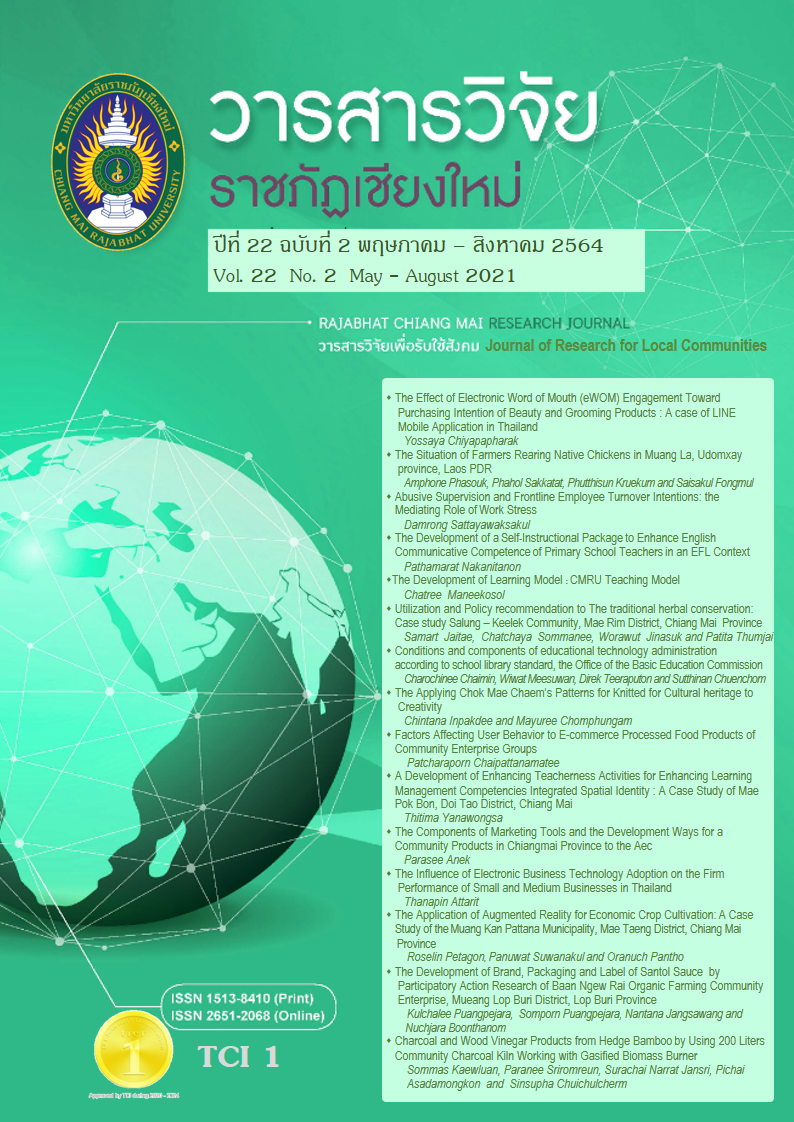การผลิตถ่านและน้ำส้มควันไม้จากไม้ไผ่เลี้ยงด้วยเตาเผาถ่านชุมชนขนาด 200 ลิตร ที่ทำงานร่วมกับหัวเผาแก๊สเชื้อเพลิงสังเคราะห์
DOI:
https://doi.org/10.14456/rcmrj.2021.243360คำสำคัญ:
ถ่านไม้ไผ่, น้ำส้มควันไม้, ไม้ไผ่เลี้ยง, เตาเผาถ่าน, หัวเผาแก๊สเชื้อเพลิงสังเคราะห์บทคัดย่อ
วัตถุประสงค์ของงานวิจัยนี้เพื่อศึกษาหาปริมาณและคุณภาพของถ่านและน้ำส้มควันไม้ที่ได้จากไผ่เลี้ยงที่มีความยาว 7.5 เซนติเมตร ความชื้นร้อยละ 27.78, 20.73 และ 13.33 โดยใช้เตาเผาถ่านแบบถังตั้งขนาด 200 ลิตร ส่วนฐานเชื่อมต่อกับชุดให้ความร้อนอุณหภูมิสูงจากเตาผลิตและหัวเผาแก๊สเชื้อเพลิงสังเคราะห์ โดยสามารถป้อนแก๊สร้อนที่มีปริมาณออกซิเจนต่ำที่ระดับอุณหภูมิสูงถึง 1,000 องศาเซลเซียส ส่วนบนของเตาเผาเชื่อมต่อเข้ากับชุดควบแน่นแบบ Shell & Coil โดยมีอัตราการไหลของน้ำระบายความร้อนที่ 4 ลิตรต่อนาที แก๊สไอเสียที่ควบแน่นไม่ได้และน้ำส้มควันไม้ดิบถูกแยกออกจากกันด้วยไซโคลน น้ำส้มควันไม้ดิบไหลเข้าสู่ถังเก็บในขณะที่แก๊สไอเสียที่ควบแน่นไม่ได้ถูกส่งไปเผาเป็นเชื้อเพลิงร่วมกับเตาชีวมวล การทดลองเสร็จสิ้นเมื่อไม่มีน้ำส้มควันไม้ไหลออกจากเครื่องควบแน่น ผลการทดลองแสดงให้เห็นว่าการใช้ไม้ไผ่ที่มีความชื้นร้อยละ 27.78 กระบวนการคาร์บอไนเซชันจะเสร็จสิ้นในเวลา 350 นาที โดยให้มวลถ่านร้อยละ 22.38 และมวลน้ำส้มควันไม้ร้อยละ 59.25 ไผ่ที่มีความชื้นสูงใช้เวลาในการเผาถ่านนาน ให้ผลผลิตถ่านต่ำ แต่ให้ปริมาณน้ำส้มควันไม้ที่มาก ในทางตรงกันข้ามการผลิตถ่านด้วยไผ่ที่มีความชื้นต่ำใช้เวลาน้อยกว่า ให้ผลผลิตถ่านมาก และให้น้ำส้มควันไม้ในปริมาณน้อย คุณภาพของถ่านและน้ำส้มควันไม้ที่ได้มีสมบัติเป็นไปตามมาตรฐานผลิตภัณฑ์ชุมชน (มผช.) การผลิตถ่านจากไผ่เลี้ยงด้วยเทคโนโลยีนี้สามารถสร้างรายได้ให้เกษตรกรได้มากถึงครั้งละ 1,729 บาท
Downloads
เอกสารอ้างอิง
Adam, J. C. (2009). Improved and more environmentally friendly charcoal production system using a low-cost retort–kiln (Eco-charcoal). Renewable Energy, 34(8), 1923-1925. DOI:10.1016/j.renene.2008.12.009
Aksornnaem, K., & Niboontum, P. (2011). Bamboo plants create the world. Kehakaset Magazine, 35(11), 76-99. (In Thai)
Homkong, K. (2014). Bamboo marketing system and trends in Thailand, Bamboo and Thai way of life, Local knowledge and management models. Bangkok: Domybest. (In Thai)
Lausakul, L., Boonsermsuk, S., & Sungkaew, S. (2014). Bamboo (Mai Pai) in Queen Sirikit's park. Bangkok: Forest research and development office. Royal forest department. (In Thai)
Lin, J.-C. M. (2006). Development of a high yield and low cycle time biomass char production system. Fuel Processing Technology, 87(6), 487-495. doi:https://doi.org/10.1016/j.fuproc.2005.07.009
Maneechot, P., Thanarak, PR., Thongsan, S., Prasit, B., Wansungnern, W., Ninwichian, P., Phetcharee. A., & Akhphin, A. (2015). Development of charcoal kiln vertical power size 200 liters by gasification techniques. The 8th Thailand renewable energy for community conference, 114-117. (In Thai)
Phoochinda, W. (2014). Environmental impact and social return of the use of biomass in community and household levels. National Institute of Development Administration (NIDA). (In Thai)
Pitaktunsakul, P. (2014). Bamboo and Livelihoods in Thailand: Local Knowledge and Management [Economic bamboo plants from the forest that are important of Thai people]. Bangkok: Domybest. (In Thai)
Rakkarn-ngan, P., Sagulpongmalee, K., Intanin, J., & Moonsri, P. (2014). Development of thermal efficiency of the 200 liters charcoal kiln by using insulate enveloped. The 7th Thailand renewable energy for community conference, 266-271. (In Thai)
Sangsuk, S., Suebsiri, S., & Puakhom, P. (2018). The metal kiln with heat distribution pipes for high quality charcoal and wood vinegar production. Energy for Sustainable Development, 47(1), 149-157. (In Thai)
Sparrevik, M., Adam, C., Martinsen, V., Jubaedah, & Cornelissen, G. (2015). Emissions of gases and particles from charcoal/biochar production in rural areas using medium-sized traditional and improved “retort” kilns. Biomass and Bioenergy, 72(1), 65-73. DOI:10.1016/j.biombioe.2014.11.016
Sungkaew, S., Teerawatananon, A., & Jindawong, K. (2011). Bamboos in Thailand. Center of Excellent for Bamboos Kasetsart University. Bangkok. (In Thai)
Thanurak, S. (1996). Economic bamboo. Industrial wood group. Division of Horticulture Promotion, Department of Agricultural Extension. Bangkok. (In Thai)
Tippayawong, N., Saengow, N., Chaiya, E., & Srisang, N. (2010). Production of charcoal from woods and bamboo in a small natural draft carbonizer. International Journal of Energy and Environment, 1(5), 911-918. www.IJEE.IEEFoundation.org
Wei-lim, G., Sungkaew, S., Teerawatananon, A., Dieter, O., Xia, N., Chan, K., How, Y., & WONG, K. (2018). The hybrid origin of Phai Liang, a bamboo of recent introduction into horticulture in Southeast Asia, and a new nothogenus, ×Thyrsocalamus (Bambuseae: Bambusinae). Phytotaxa, 362(3), 271-281. doi:10.11646/phytotaxa.362.3.3
ดาวน์โหลด
เผยแพร่แล้ว
รูปแบบการอ้างอิง
ฉบับ
ประเภทบทความ
สัญญาอนุญาต
1. บทความ ข้อมูล เนื้อหา รูปภาพ ฯลฯ ที่ได้รับการตีพิมพ์ใน “Community and Social Development Journal” ถือเป็นลิขสิทธิ์ของ Community and Social Development Journal มหาวิทยาลัยราชภัฏเชียงใหม่ และเพื่อให้เผยแพร่บทความได้อย่างเหมาะสมผ่านสื่อสิ่งพิมพ์และอิเล็กทรอนิกส์ ผู้เขียนยังคงถือครองลิขสิทธิ์บทความที่ตีพิมพ์ภายใต้ใบอนุญาต Creative Commons Attribution (CC BY) ซึ่งอนุญาตให้เผยแพร่บทความซ้ำในแหล่งอื่นได้ โดยอ้างอิงต้องอ้งอิงบทความในวารสาร ผู้เขียนต้องรับผิดชอบในการขออนุญาตผลิตซ้ำเนื้อหาที่มีลิขสิทธิ์จากแหล่งอื่น
2. เนื้อหาบทความที่ปรากฏในวารสารเป็นความรับผิดชอบของผู้เขียนบทความโดยตรง ซึ่งกองบรรณาธิการวารสารไม่จำเป็นต้องเห็นด้วยหรือร่วมรับผิดชอบใดๆ














